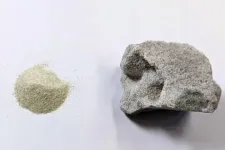DDT exposure in grandmothers linked to obesity, earlier periods in granddaughters
Young women today may face increased health risks linked to breast cancer due to effects from the banned toxic pesticide lasting over three generations
2021-04-14
(Press-News.org) Oakland, CA-In the first study to report on the health effects of exposure to a toxic environmental chemical over three human generations, a new study has found that granddaughters whose grandmothers were exposed to the pesticide DDT have higher rates of obesity and earlier first menstrual periods. This may increase the granddaughters' risk for breast cancer as well as high blood pressure, diabetes and other cardiometabolic diseases.
The research by the Public Health Institute's Child Health and Development Studies (CHDS) and the University of California at Davis was published today in Cancer Epidemiology, Biomarkers & Prevention, a journal of the American Association for Cancer Research. It suggests that effects from the pesticide DDT -- despite being banned in the U.S. nearly 50 years ago -- may contribute to the falling age of first periods and increases in obesity rates among young women today.
The study found that the risk of obesity in young adult granddaughters was 2 to 3 times greater when their grandmothers (who were not overweight) had higher levels of o,p'-DDT (a contaminant of commercial DDT) in their blood during or just after pregnancy. Granddaughters were twice as likely to have earlier first menstrual periods when their grandmothers had higher o,p'-DDT blood levels. DDT and its related chemicals, including o,p'-DDT, are known to be endocrine disrupting chemicals, compounds that can alter and interfere with natural hormones that are essential for development.
"We already know that it's nearly impossible to avoid exposures to many common environmental chemicals that are endocrine disruptors. Now our study shows for the first time in people that environmental chemicals like DDT may also pose health threats to our grandchildren," said Barbara Cohn, director of CHDS and senior author of the study. "In combination with our on-going studies of DDT effects in the grandmother's and mother's generations, our work suggests we should take precautionary action on the use of other endocrine disrupting chemicals, given their potential to affect generations to come in ways we cannot anticipate today."
The Child Health and Development Studies is a unique project that has followed 20,000 pregnant women and their families for more than 60 years. CHDS enrolled and began following pregnant women in the Bay Area between 1959 and 1967, a time of high pesticide use before DDT was banned in 1972. These "founding grandmothers" in the study gave blood samples at each trimester during pregnancy and one sample shortly after birth. The blood samples were tested for levels of DDT and its related chemicals, including active ingredients, contaminants and their metabolites. The study today focused on o,p'-DDT as it has previously been linked to breast cancer, obesity and other harmful health effects in daughters, and is believed to be the most sensitive biomarker for exposures before and immediately after birth. Since granddaughters' exposure would occur via their mothers' in utero egg cell development, o,p'-DDT levels are a potential predictor of granddaughters' exposure outcomes.
"These data suggest that the disruption of endocrine systems by DDT initiates in immature human eggs, decades before the eggs are fertilized," said Michele La Merrill, associate professor at UCD who was co-lead author of the study.
The CHDS study included interviews, home visits and questionnaires from the daughters and granddaughters of the original enrollees. During home visits, blood pressure and height and weight measurements were taken. The study today is based on 365 adult granddaughters who completed questionnaires, participated in a home visit, had available DDT measures from grandmothers' serum, and (for 285 of them) had available information on body mass index (BMI) in all three generations. Information on the age of first period for all three generations was available from 235 granddaughters.
Previous CHDS studies have shown that mothers' DDT exposure during pregnancy or immediately after birth correlates with increased daughters' risk of breast cancer and the prevalence of breast cancer risk factors, including obesity, among adult daughters. Other prior studies have linked DDT exposure to birth defects, reduced fertility and an increased risk of diabetes.
A commentary in the journal Reproductive Toxicology last year called CHDS "a national treasure that keeps on giving" and noted that "There are no other U.S. studies as well defined, sampled, and followed as the CHDS....The CHDS provides unique and essential value in understanding health effects of environmental exposures as they relate to life-stage sensitivity."
INFORMATION:
The research published today was supported by the California Breast Cancer Research Grants Program, the Breast Cancer Environment Research Program of the National Institute of Environmental Health Sciences (NIEHS), the Eunice Kennedy Shriver National Institute of Child Health and Human Development, and the USDA National Institute of Food and Agriculture.
The abstract of the study "Grandmaternal perinatal serum DDT in relation to granddaughter early menarche and adult obesity: Three generations in the Child Health and Development Studies cohort" will be available on the journal website on April 14. Learn more about Child Health and Development Studies at https://www.phi.org/our-work/programs/child-health-and-development-studies/.
ELSE PRESS RELEASES FROM THIS DATE:
2021-04-14
WINSTON-SALEM, N.C. - April 14, 2021 - Investigators at Wake Forest School of Medicine, part of Wake Forest Baptist Health, have identified a set of new genetic markers that could potentially lead to new personalized treatments for lung cancer.
The study appears online in Cancer Research, a journal of the American Association for Cancer Research.
This study was built on a previous discovery by the precision oncology team at Wake Forest Baptist's Comprehensive Cancer Center, directed by Wei Zhang, Ph.D., professor of cancer biology at Wake Forest School of Medicine and a co-corresponding author of this study. Using DNA sequencing technologies, Zhang's team found that tumors with mutated KMT2 genes, a family of proteins, exhibit a feature ...
2021-04-14
A new study based on daily COVID-19 data from Brazil details the fast spread of both cases and deaths in the country, with distinct patterns by state, and where inequities regarding the implementation of policies and resources exacerbated the spread in lower-income regions. Despite an extensive network of primary care availability, Brazil - which did not pursue a coordinated national pandemic response strategy - has suffered greatly during the COVID-19 pandemic. "[T]he federal response has been a dangerous combination of inaction and wrongdoing," write Marcia Castro and colleagues. Using daily data from State Health Offices, Castro ...
2021-04-14
A new report tracks the evolution of a variant lineage of SARS-CoV-2 associated with rapid transmission in Manaus, Brazil, that evolved in November 2020. The study's authors suggest this variant, "P.1," may be more transmissible and more likely to evade protective immunity elicited by previous infection with non-P.1 lineages. Manaus, Brazil, reached unprecedented levels of SARS-CoV-2 transmission in mid-2020. And after a momentary respite, cases surged with fatal consequences. Using molecular clock analysis, Nuno Faria et al. tracked the evolution of a new, more aggressive lineage called P.1, which possesses 17 mutations, including three (K417T, ...
2021-04-14
We refer to the microbiome as the community of microorganisms that exist in or on all organisms, including bacteria and fungi. A team from the Institute of Environmental Biotechnology at Graz University of Technology (TU Graz) led by Institute head Gabriele Berg has now investigated the microbiomes of apples and oil pumpkins in two independent studies. The researchers have found that bacteria useful to plants are largely "inherited," i.e., passed on to the next generation, while the community of fungi in the microbiome is highly dependent on the particular soil microbiome and thus on the locality.
Microbiome-guided breeding of oil pumpkins
The breeding ...
2021-04-14
When people are asked to draw the flower of a sunflower plant, almost everyone draws a large circle encircled by yellow petals.
"Actually, that structure is the flower head, or the capitulum, which may be composed of hundreds of flowers, also known as florets. The surrounding 'petals' are florets different in structure and function to those closer to the centre," says Professor of Horticulture Paula Elomaa from the Faculty of Agriculture and Forestry, University of Helsinki, Finland.
A giant inflorescence is beneficial, as it is effective in attracting pollinators. When pollinators move around the inflorescence, they pollinate hundreds of individual florets over the course of ...
2021-04-14
Tokyo, Japan - Researchers at the Institute of Industrial Science, a part of The University of Tokyo, have developed a new method of producing concrete without cement. They have directly bonded sand particles via a simple reaction in alcohol with a catalyst. This may help both to slash carbon emissions and to construct buildings and structures in desert regions, even on the Moon or Mars.
Concrete consists of two parts: the aggregate (typically made of sand and gravel) and cement (responsible for 8% of total global CO2 emissions). Despite there being a huge amount of sand in the world, the availability of sand for concrete production is fairly limited because sand particles must have a specific size distribution ...
2021-04-14
A recent study has unveiled the reason behind the exceptional catalytic performance of non-noble metal-base mixed catalysts. This is thanks to a new synthetic strategy for the production of cube-shaped catalysts that could further simplify the structure of complex catalysts.
This breakthrough has been led by Professor Kwangjin An and his research team in the School of Energy and Chemical Engineering at UNIST, in collaboration with Professor Taeghwan Hyeon and his research team from Seoul National University. In their study, the researchers found a new principle that active charge transfer, which appears at the interface created between the two types of non-noble ...
2021-04-14
TMDs vdW heterostructures generally possess a type-II band alignment which facilitates the formation of interlayer excitons between the constituent monolayers. Manipulation of the interlayer excitons in TMDs vdW heterostructures hold great promise for developing excitonic integrated circuits that serve as the counterpart of electronic integrated circuits, which allows the photons and excitons transforming between each other and thus bridges the optical communication and signal processing at the integrated circuit. Consequently, numerous researches have been carried out in order to get a deep insight ...
2021-04-14
A wide range of objects, from biological cells to integrated circuits, are tomographically imaged to identify their interior structures. Volumetric reconstruction of the objects' interiors is of practical implications, for instance, quantitative phase imaging of the cells and failure analysis of the circuits to validate their designs. Limiting the tomographic angular range is often desirable to reduce the time of radiation exposure and avoid any devastating effects upon the samples, or even unavoidable due to the structure of objects like in the case of tomosynthesis for mammography. However, tomographic reconstruction from limited angular views is not always welcome in an algorithmic sense, ...
2021-04-14
Research by Australian scientists could pave the way to a new treatment for a currently incurable brain cancer in children called Diffuse Intrinsic Pontine Glioma, or DIPG. Affecting about 20 children in Australia each year, DIPG is a devastating disease with an average survival time of just nine months after diagnosis.
The research, led by scientists at Children's Cancer Institute and published this week in the international journal, Cell Reports, offers an exciting new therapeutic approach for the treatment of DIPG by using a new anti-cancer drug.
The new drug, CBL0137, is an anti-cancer compound developed from the antimalarial drug quinacrine. The researchers found that CBL0137 directly ...
LAST 30 PRESS RELEASES:
[Press-News.org] DDT exposure in grandmothers linked to obesity, earlier periods in granddaughters
Young women today may face increased health risks linked to breast cancer due to effects from the banned toxic pesticide lasting over three generations



